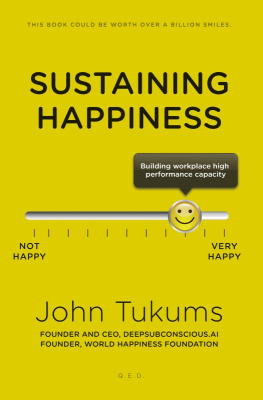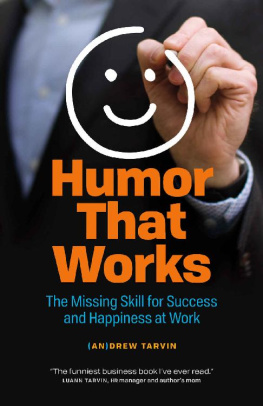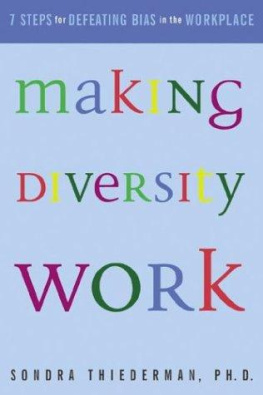Mark Price - Six Steps to Workplace Happiness
Here you can read online Mark Price - Six Steps to Workplace Happiness full text of the book (entire story) in english for free. Download pdf and epub, get meaning, cover and reviews about this ebook. year: 2018, publisher: David Fickling Books Ltd, genre: Business. Description of the work, (preface) as well as reviews are available. Best literature library LitArk.com created for fans of good reading and offers a wide selection of genres:
Romance novel
Science fiction
Adventure
Detective
Science
History
Home and family
Prose
Art
Politics
Computer
Non-fiction
Religion
Business
Children
Humor
Choose a favorite category and find really read worthwhile books. Enjoy immersion in the world of imagination, feel the emotions of the characters or learn something new for yourself, make an fascinating discovery.
- Book:Six Steps to Workplace Happiness
- Author:
- Publisher:David Fickling Books Ltd
- Genre:
- Year:2018
- Rating:5 / 5
- Favourites:Add to favourites
- Your mark:
- 100
- 1
- 2
- 3
- 4
- 5
Six Steps to Workplace Happiness: summary, description and annotation
We offer to read an annotation, description, summary or preface (depends on what the author of the book "Six Steps to Workplace Happiness" wrote himself). If you haven't found the necessary information about the book — write in the comments, we will try to find it.
Six Steps to Workplace Happiness — read online for free the complete book (whole text) full work
Below is the text of the book, divided by pages. System saving the place of the last page read, allows you to conveniently read the book "Six Steps to Workplace Happiness" online for free, without having to search again every time where you left off. Put a bookmark, and you can go to the page where you finished reading at any time.
Font size:
Interval:
Bookmark:
- Measurement:
measuringworkplacehappiness.com
by Mark Price
In the beginning was the idea and the idea was good, so good it became a machine.
The machine only exists to make money for those who own it.
The machine doesnt care about the consequences of its actions if it makes more money.
The machine that hesitates is consumed by another.
The machine doesnt mind being consumed if it makes more money for the owners.
The machine demands consistency, order, uniformity, process and efficiency.
The machine keeps making new rules and ways to check them.
The machine doesnt trust.
The machine gives orders, but doesnt explain.
The machine talks to you, but you cant talk to it.
The machine has to grow.
The machine demands more each year.
The machine that breaks down has its broken parts reused or discarded.
There is a different way.
There are the six steps that drive the happiness of employees:
Step One: Reward and recognition
Pay is important in any job, but linking it to recognition is a powerful motivator.
Step Two: Information sharing
An open, transparent culture ensures widespread understanding of objectives.
Step Three: Empowerment
Once employees know what needs to be done, if you empower them theyll make intelligent suggestions and be more committed to the best way forward.
Step Four: Well-being
A happy, healthy workforce is better equipped to do business.
Step Five: Instilling pride
Pride in the workplace and its status in society adds to fulfilment.
Step Six: Job satisfaction
A culture of trust and respect engages on a personal level and encourages a stronger bond.
These elements control our sense of happiness in what we do each working day and, in turn, ensure we give the best we have to get the job done. If you visit measuringworkplacehappiness.com you or your organisation can get both quantitative and qualitative measurements of happiness.
For more than three decades I worked for The John Lewis Partnership whose supreme purpose was the happiness of its employees, or Partners as they are called, not maximising shareholder returns or being customer-centric, but putting employee well-being first.
Over the last ten years, as a business leader and government minister, I have heard increasing calls for a more inclusive capitalism and a fairer form of capitalism as a response to the financial crisis of 2008 and the perceived and real excesses of capitalism. There is a widely held belief that there is too large a gap between the haves and the have-nots, that jobs are being lost to technology and cheaper labour, and that as a result people are working harder to stand still, and that big business is acting unfairly, and that institutions and governments are failing the people.
To my mind, inclusive capitalism means engaging employees more in their organisations success, and in so doing, more fairly balancing rewards and responsibility, not just for the employees benefit, but also for that of customers and local communities as well as shareholders and business leaders. This is sustainable capitalism.
I believe there is a moral as well as an economic imperative for employees to be more engaged in their organisations any organisation. The straightforward message is that if you focus first and foremost on your employees well-being and happiness, your organisation will do better and society will be better off too. That is because workplace happiness is derived from a sense of ownership and control and feeling positive about the environment in which you work. It drives increased productivity and commitment, which drives increased customer satisfaction, which drives increased profitability from which shareholders and society benefits.
The lessons I draw from my experience are summarised here, but are set out in more detail in my book Fairness For All. In it, through numerous examples, I have tried to show that elements of the JLP model can translate very successfully elsewhere however your business or organisation is constructed. If employee happiness is the objective, it is possible to create a sense of ownership and responsibility around a business in a range of ways. Individuals who feel they have more power over their working life, well-being and environment will take more responsibility for the success of their employer. The endgame should be a more engaged society that promotes greater happiness, collective endeavour and a fairer sharing of success.
Well thought-out reward and recognition initiatives, coupled with a conducive working environment, help create sustainable long-term teams, and businesses that are beneficial to employees, the community and society as a whole.
- That everyone in an organisation enjoys the rewards of success.
- If youre not paying a fair salary no amount of recognition for a job well done will be enough to make employees forget they are not being paid enough.
- Your pay scale has to meet expectations and encourage discretionary effort.
(In The John Lewis Partnership all individuals are paid the market rate for their job, and as much above as can be justified by their performance.)
But to maximise employees performance and pay it is important to recognise you need the following three things from those managing:
- Leadership which is consistent, and shows a sincere interest in the team.
- Managers who are consistent, impartial and honest and willing to provide appropriate feedback and coaching.
- Goals of both business and individuals should be clearly and explicitly understood and expressed and whenever possible set by those delivering them so that they are truly owned.
In the Partnership, each Partner is guaranteed an equal percentage share in the profits, from the Chairman to the part-time student. As set out in the constitution, the highest-paid director is not allowed to earn more than seventy-five times as much as a non-management employee. But fairer sharing in The John Lewis Partnership goes beyond pay and bonus. There are generous subsidies for Partners to enjoy their hobbies, a market-leading pension scheme to reward longevity of service, and holiday centres for employees to use. These are all designed to recognise and reward the team as well as individual merit.
Research and experience has shown me that recognising a individuals performance with a thank you, a note of congratulation or small gift of acknowledgement, is a powerful motivator. It says good work has been noticed throughout the year, not just at an annual appraisal. It builds bonds and trust and increases engagement.
- Sharing information is the most important and difficult element of achieving an engaged workforce.
- Not sharing information makes employees feel an unimportant part of the business. Engagement and commitment is eroded by this.
- The closed-door approach doesnt just have a negative impact on engagement, it can directly impact on decision-making, and therefore profitability and success.
We all need to have a realistic and well-sourced view of the organisations where we work, regardless of whether we are the chief executive or work on the shop floor. The level of detail in which we receive it may be different, but information forms the basis of the decisions we make every day.
- A culture where information is freely available is fundamental to achieving each of the six steps to happiness.
Font size:
Interval:
Bookmark:
Similar books «Six Steps to Workplace Happiness»
Look at similar books to Six Steps to Workplace Happiness. We have selected literature similar in name and meaning in the hope of providing readers with more options to find new, interesting, not yet read works.
Discussion, reviews of the book Six Steps to Workplace Happiness and just readers' own opinions. Leave your comments, write what you think about the work, its meaning or the main characters. Specify what exactly you liked and what you didn't like, and why you think so.










